CBG-rich cannabis products
Cannabigerol products designed to promote focus, digestion, and rejuvenation
1:1 CBG + CBD
1mL serving = 10mg CBG + 10mg CBD
1oz tincture contains 300mg CBG + 300mg CBD
2oz tincture contains 600mg CBG + 600mg CBD
Ingredients: Fractionated coconut oil, full spectrum cannabis extract, CBG isolate from hemp
CBG and CBD are both non-intoxicating, making this the perfect formula for daytime use.
1:1 CBG + THC
1mL serving = 10mg CBG + 10mg THC
1oz tincture contains 300mg CBG + 300mg THC
2oz tincture contains 600mg CBG + 600mg THC
Ingredients: Fractionated coconut oil, full spectrum cannabis extract, CBG isolate from hemp
1:1:1:1 CBN + CBG + THC + CBD
1mL serving = 10mg CBN + 10mg CBG + 10mg THC + 10mg CBD
1oz tincture contains 300mg CBN + 300mg CBG + 300mg THC + 300mg CBD
2oz tincture contains 600mg CBN + 600mg CBG + 600mg THC + 600mg CBD
Ingredients: Fractionated coconut oil, full spectrum cannabis extract, CBG isolate from hemp, CBN isolate from hemp
Formulated to help with whatever ails the mind and body.
1g CBG-rich FECO2
Each gram contains ~50% THC + ~20% CBG.
Ingredients: full spectrum cannabis extract, hemp extract
CBG-rich FECO2 is a great edible option for getting the potent benefits of CBG and THC together.
1g CBG-rich Cartridges
Each 1g cartridge contains ~50% THC and ~25% CBG
Ingredients: full spectrum cannabis extract, hemp extract
What is CBG and how does it affect the body?
Our wonderful partners at Lightscale Labs have shared this great info on CBG!
You’ve probably heard CBG called “The Mother of Cannabinoids.” That’s bc CBG is the chemical precursor to THC & CBD. (Fun Fact: Cannabis does not actually produce THC or CBD! 🤯 UV light & special enzymes convert CBG into THC, CBD, or the elusive CBC.)
This non-psychoactive cannabinoid typically shows up in flower at <1% potency, but selective breeding and extraction have made CBG more abundant, & readily available. So what happens when a human being consumes a large dose of CBG?
First, CBG attaches to the same CB1&2 neuron receptors that THC loves… but ALSO the Capsaicin receptors CBD loves, AND Serotonin receptors, AND Adrenaline receptors. So suffice it to say, CBG has the potential to make a LOT of changes to your biochemistry, & the way your body functions.
Because of its many functions in the body, isolated CBG has shown a ton of promise as medicine. Purified CBG has alleviated intestinal inflammation from IBS (for mice) and relieved glaucoma symptoms (for cats). It has shown tremendous potential for protecting and even generating new neurons in instances of (mouse) Parkinson’s and (mouse) Multiple Sclerosis. Most amazingly, CBG slowed tumor growth in instances of both ovarian and breast cancer (in a test tube).
But multiple medical functions always come with multiple possible side effects. (Side note: this is ALWAYS true. There are no miracle cures. Even drinking too much water can kill you.) Some researchers are concerned that CBG’s affinity for adrenaline receptors means large doses could cause unpredictable changes to blood pressure or interactions with heart medications, & its affinity for serotonin receptors could throw psychiatric meds out of whack.
Just like with any potent, powerful medicine, CBG has both positive and negative potential. The outcome (probably) depends on your personal medical situation.
Much like CBN, cannabigerol (CBG) is another minor cannabinoid that is making major moves within the medical cannabis community. While there hasn’t been an abundance of studies involving CBG yet, the ones that have been conducted show immense promise of CBG’s diverse medical value.
Like it’s sibling CBD, cannabigerol has been shown to have therapeutic and pain-relieving qualities without intoxicating effects.
Because CBG binds to both CB1 and CB2 receptors in our endocannabinoid system it is believed to play a role in enhancing pleasure and motivation, regulating appetite, digestion and sleep, and alleviating pain.
A preliminary study with animals performed in 2013 showed promise in treating Inflammatory Bowel Disease.
“Researchers induced inflammations similar to IBD in the colons of mice and then administered CBG. CBG was found to reduce the inflammation and the production of nitric oxide. It also reduced the formation of reactive oxygen species (ROS) in the intestines. They concluded that CBG should be considered for clinical experimentation in IBD patients.”
In 1990 a study was conducted on cats with glaucoma. Researchers administered CBG to the cats and observed a reduction in eye pressure and an increase in aqueous humor outflow, a fluid produced by the eye which maintains eye pressure and provides the eye with nutrition.
From another study done on mice in 2015 researchers determined that CBG acts as a neuroprotectant, protecting the nerve cells in the brain from damage.
A 2014 study on rats infected with colon cancer, researchers found that CBG was effective in blocking the receptors that cause cancer cell growth and inhibiting the growth of the cancerous cells.
In a 2020 study on the potential antibiotic properties of cannabis researchers found that CBG was in fact antibacterial and was especially effective against strains of MRSA, a bacteria which causes staph infections and is drug-resistant.
References:
What is CBG? The minor cannabinoid with major potential, explained. Journal of Cannabinoid Medicine.
Borrelli F, Fasolino I, Romano B, et al. Beneficial effect of the non-psychotropic plant cannabinoid cannabigerol on experimental inflammatory bowel disease. Biochemical Pharmacology. 2013;85(9):1306-1316.
Colasanti BK. A comparison of the ocular and central effects of tetrahydrocannabinol and cannabigerol. Journal of Ocular Pharmacology and Therapeutics. 1990;6(4):259-269.
Valdeolivas S, Navarrete C, Cantarero I, Bellido ML, Muñoz E, Sagredo O. Neuroprotective properties of cannabigerol in huntington’s disease: studies in r6/2 mice and 3-nitropropionate-lesioned mice. Neurotherapeutics. 2015;12(1):185-199.
Farha MA, El-Halfawy OM, Gale RT, et al. Uncovering the hidden antibiotic potential of cannabis. ACS Infect Dis. 2020;6(3):338-346.
Orrego-González E, Londoño-Tobón L, Ardila-González J, Polania-Tovar D, Valencia-Cárdenas A, Velez-Van Meerbeke A. Cannabinoid effects on experimental colorectal cancer models reduce aberrant crypt foci (Acf) and tumor volume: a systematic review. Evidence-Based Complementary and Alternative Medicine. 2020;2020:1-13.
If you’ve tried one of our CBG products, please help us in better understanding the effects of CBG by providing your feedback on the form below.
No personal information is required.
Feel free to submit multiple times if you use a CBG product repeatedly and would like to share any change in effect.





